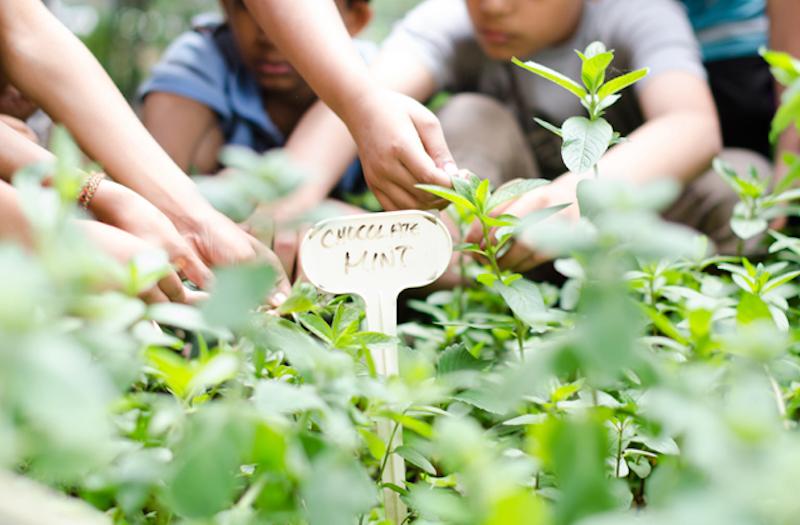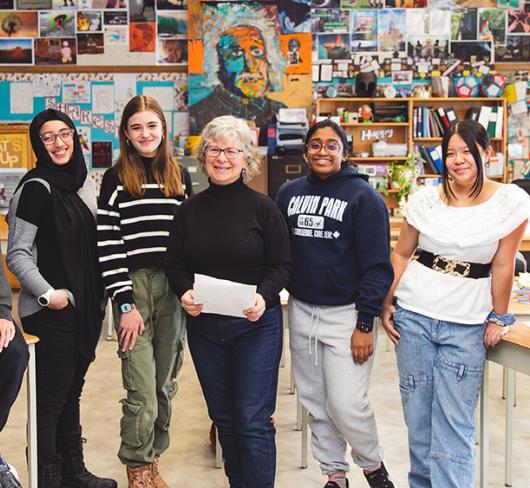
Plant the Seed of The School Garden: In Conversation with Green Thumbs for Growing Kids Program Director Sunday Harrison
What was the inspiration for the Green Thumbs program?
Originally the inspiration stemmed from wanting my own child to have a hands-on gardening and nature program as part of his childhood. What I wanted for him was the opportunity to explore and connect with nature through food gardening because it was such a pleasure for me, as a child and much later as an adult, to learn about plants and gardening.
The garden is where nature meets culture, and where I think kids start to care about the environment. The absolute joy they express at the smallest things we might take for granted – a worm, a snail – gives us, the adults, our own new found sense of wonder and curiosity. Early exposure to soil helps kids understand the source of life as being the natural world – sun, soil, rain, and plants – and to grasp this with all of their five senses, experientially.
Why is growing food in a community important?
Food production, until quite recently, was much closer to home. School gardens are not a new idea – they were the norm in Ontario earlier in the last century, and are common in less-developed nations as part of food security. Here in downtown Toronto, the high-density urban environment separates us from our food, but even smaller towns and rural schools are full of kids who don’t know where food comes from, because industrial-scale agriculture is no more accessible to kids than any other factory. So kids are quite surprised when we say that healthy soil makes healthy food – in fact, they are sometimes surprised that soil is in the equation at all. Everything purchased at the grocery store is free of dirt!
What are some of the practical benefits of school gardens?
Practical benefits include physical activity, hands-on learning, and increased mental health, along with a better diet. Fresh fruits and veggies are so important, but most of us are not getting enough of these powerful disease-fighting foods. Children, especially those from families on low incomes, are often not getting enough micro-nutrients found in fresh foods. Even the small amounts that they get in the school garden can make a difference. The ripple effect is that they develop a taste for these foods, and start to request them at home and in the school cafeteria. I’ve had many parents comment that it’s the school garden that got their kid to eat vegetables, and many times I’ve observed kids trying new foods in the garden that I doubt they would eat if presented on a plate indoors. Curiosity and peer modelling help kids eat better, and best of all is they’re having fun – they’re not doing it because they have to. The nurturing behaviour that accompanies gardening helps build empathy and social skills.
For kids who are just learning English, the chance to participate in group activities to absorb the new vocabulary equalizes the playing field, and supports positive peer engagement. In our gardens we strive to have a variety of cultural favourites growing, so that children see foods that are familiar. One example of this is callaloo, also called shak, which is a very nutritious green used like spinach and common among many Asian and Caribbean cuisines. I can imagine that foods like this can serve as a sort of emotional bridge between home and school for newcomers.
Finally, by continuing robust programming and access to the gardens through summer, we make a real contribution to food security in our community, where fresh foods are often too expensive for ordinary people.
What kinds of curriculum expectations can be met by teaching in the garden?
The easiest fit for elementary grades is in the science curriculum, but there are some strands in other subject areas, such as health and nutrition, social studies, and also many ways to use the garden as a springboard for math (perimeter, area, volume), language (signs, stories), and art (art about the garden, art for the garden). Kindergarten has great links with the five senses and recycling/composting.
Within the science curriculum, there are good links in most grades. Needs of animals (1), air and water in the environment (2), plants and soils (3), habitats and communities (4), and biodiversity (6) and composting (8) all lend themselves to lesson plans with a garden component. The environmental education that is now mandated by the Ontario Ministry of Education can be carried out in part in the school garden.
What advice would you give to teachers who are interested in starting a small garden in their school?
Every school is different, so spend some time to determine the best location that is close to water and gets adequate sun. Don’t be put off by a bit of shade – lots of herbs and leafy greens will grow fine in four to six hours of sun per day, and you don’t need to water as much as gardens in full sun. Consider early perennials (sorrel, rhubarb, mint, chives) and short-season annuals (lettuce, spinach, radish, peas) for spring and fall growth, if summer care is a problem. In many regions, you can start seeds under plastic row covers in February and March, yielding an early crop.
Growing indoor crops like pea shoots and sunflower sprouts can be a great way to introduce yourself and your students to the fun and magic of gardening, even without a garden.
For outdoor gardens, if watering needs to be done outside the instructional day, make sure that you have access to automatic sprinklers or volunteers who want to help keep the plants watered. Plants are vulnerable to drought, especially in the spring.
If planting for fall harvest, use hardy plants such as tomatoes, potatoes, carrots, beets, and kale that can survive the heat of summer with minimal care.
Heavy mulch with straw or leaves can protect root crops from drought. In fall, plant garlic for the following summer harvest – it’s a useful companion to other plants, and the flowers (called scapes) make a good spring crop. If you are looking for volunteers to help with children in the garden, many cities and towns have Master Gardeners, some of whom may be especially interested in school gardens. They may be reached through the local horticultural society. Local community gardeners are another source of support and knowledge.
Check with local businesses that might be happy to donate small amounts of supplies and tools to the gardening project.

